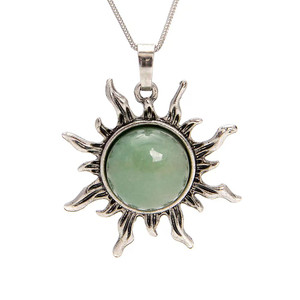
Aventurine, Quartz, Green, Natural, Heart Shape One Pendant, 35x27mm
Aventurine, Quartz, Green, Natural, Heart Shape
One Pendant in a Metal Alloy Finding, 35x27mm
Aventurine is a form of quartz which is a hard, crystalline mineral composed of silicon and oxygen atoms and is the second most abundant mineral in Earth's continental crust, behind Feldspar. Aventurine is characterized by its translucency and the presence of platy mineral of inclusions that give a shimmering, reflective or glistening effect termed aventurescence.
The most common color of Aventurine is green, but it may also be orange, brown, yellow, blue, or grey. Aventurine’s most common inclusion is Fuchsite, a green chromium-rich mica. Flakes of Lepidolite Mica can impart a pink, red or purple color. Hematite can produce pink, orange, red, and brown Aventurine. Muscovite can produce gray, yellowish or silvery Aventurine. Dumortierite inclusions cause the Aventurine to be blue.
Small amounts of Aventurine have been found in many parts of the world. India is by far the most important commercial producer of Aventurine. Brazil is the second-place producer. South Africa, Russia, Spain, Austria, and Tanzania produce Aventurine.
Hardness 6.5
This is a natural stone that has had no treatment other than cutting, drilling, and polishing done in China.
Metal Alloy is a metal made by combining two or more metallic elements, base metals, to give greater strength or resistance to corrosion. In mining and economics, base metals refer to industrial non-ferrous metals excluding precious metals, like silver, gold, and platinum. Base Metals include copper, aluminum, nickel, tin, zinc antimony, bismuth, lead and many more. Metal Alloy, also known as Pewter and is usually a tin based alloy 85-95% of the time but could also be zinc based.
In December of 1994, The US Safe Drinking Water Act defined Lead-free as having less than 0.25% lead content. Most newly made solid pewter on the market today is considered lead free by these standards. But it is still recommended to not give children Metal Alloy jewelry if there is any chance, they will put it in their mouths!











